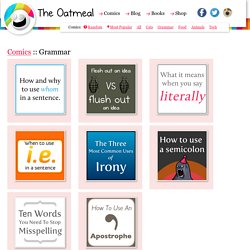

Voice Dream Writer Proofs Your Writing With Text-To-Speech. Grammar. This is a grammar comic about the proper usage of who versus whom.

A look at the meaning of "flushing out an idea. " This comic will LITERALLY make butterflies explode out of your underpants. A guide explaining when to use i.e. instead of e.g. A little bit ironic, dontcha think? The most feared punctuation on earth. The right way to use an apostrophe (in illustrated form). All artwork and content on this site is Copyright © 2016 Matthew Inman. Interpreting%20essay%20questions. Using the comma. For a printer-friendly PDF version of this guide, click here This guide explains how the comma (,) can be used to make your writing clear, unambiguous and easy to read.

It gives examples of the main uses of the comma, and highlights some commonly encountered problems. Other Useful Guides: Using the semi-colon and colon, Using the apostrophe. Why use commas? Commas are used to divide or separate parts of a sentence in order to make the meaning clear and the sentence easier to read. Using commas to separate items in a list Commas are used to separate the individual words or phrases that together make up a list.
The fish kept in the ponds were eels, tench, pike, perch and carp.The main reasons for the closure were low enrolment, poor learning material, staff recruitment problems and inadequate funds. Note that a comma is not normally used before the last item in the list, unless it is needed for clarification. Here, a comma is used before the last item in the list to avoid confusion. Everyday life, done better. Get inspired.

Get organized. Get more done. Get Started Get Started Get the App Get the App it's free! Save almost anything Products, places, recipes, books, checklists, tasks and more Notebooks for all of life’s projects. The art of editing. For a printer-friendly PDF version of this guide, click here This Study Guide addresses the process of editing an extended document such as a dissertation or a thesis.

Related Study Guides are: Writing a dissertation; Using paragraphs; and Writing for science. Introduction When you start to produce a piece of written work, you are likely to be aware of various targets and standards that you need to work to, such as: the stipulated word limit;the required level of academic writing;the need to present material in a clear and logical order; andthe necessary high standards in spelling, referencing, and grammar. However, if you become too concerned at this stage about the required standard of the end product, you may feel reluctant to begin writing at all. This is why making a clear separation between the processes of ‘writing’ and ‘editing’ can be helpful. What is editing? Typical aspects of writing that you can critique within the editing process include: Where to work? Assignment Toolkit. Academic Phrasebank. Grammar Beagle. Tone Analyzer.
Ink Paste Helps You Learn New Vocabulary Words as You Come Across Them. Hemingway. Untitled. Dyswritesq3r. Terms_and_defn_tcm44-41156. FORCEdraft Doesn't Let You Quit Writing Until You Hit Your Goal. How to Use Pocket Like a Pro to Save Everything from the Web. Master the Art of Reading with Lewis Carroll’s Four Rules of Learning.